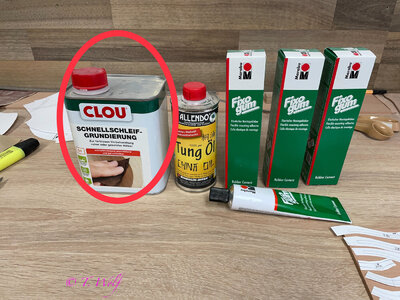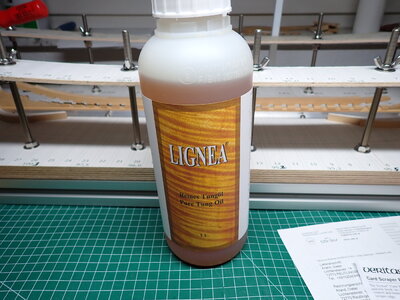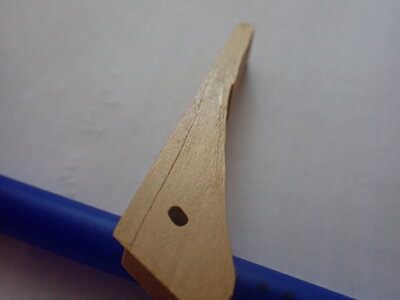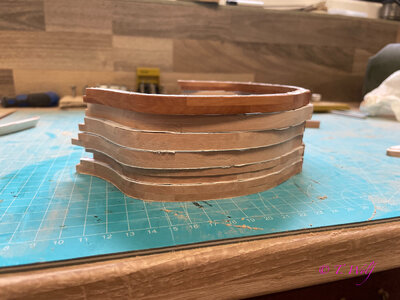-

Win a Free Custom Engraved Brass Coin!!!
As a way to introduce our brass coins to the community, we will raffle off a free coin during the month of August. Follow link ABOVE for instructions for entering.
You are using an out of date browser. It may not display this or other websites correctly.
You should upgrade or use an alternative browser.
You should upgrade or use an alternative browser.
LE ROCHEFORT - Harbour yacht from 1787 1:36 by Tobias (Monograph by ANCRE)
- Thread starter Tobias
- Start date
- Watchers 70
-
- Tags
- ancre group build le rochefort
Thank you very much for your help and opinions, they are really very useful and encourage me.
 Hello,
Hello,
At that time we did not use the mineral tar of the petroleum that we know today and that is black. Only plant-based tar made from pine resin, which is reddish brown, was used.
Translation of GD's answer.
As far as I could read on Wikipedia, this Hartz was heated and through this process it got a red-brown, brown or even black colour, I guess it depends on the duration of the heating.
 Hello,
Hello,At that time we did not use the mineral tar of the petroleum that we know today and that is black. Only plant-based tar made from pine resin, which is reddish brown, was used.
Translation of GD's answer.
As far as I could read on Wikipedia, this Hartz was heated and through this process it got a red-brown, brown or even black colour, I guess it depends on the duration of the heating.
Hi Dieter, in this case I only treated it with beeswax, at Le Coureur I used tung oil and will probably keep it. Another option would be Cluou Sanding Primer. As I said, I'm still very unsure about this.I would also use the reddish brown tissue paper. It looks very harmonic in combination with the wood.
And yes, GD described it as reddish brown, so this should also be the correct color.
What do you use as surface treatment for the wood? Is it tung oil?

Hi Tobias,Hi Dieter, in this case I only treated it with beeswax, at Le Coureur I used tung oil and will probably keep it. Another option would be Cluou Sanding Primer. As I said, I'm still very unsure about this.
Yes, the surface treatment is also still an open topic for me. But fortunately I am still far away from this task
I have already started some tests, but I am not sure yet what I will use at the end of the day.
- Shellac: I did some tests, but shellac leaves shiny spots or areas on the surface. At least I can't get it to work.
- Tung oil: I really like the results and it applies well. So this is my favorite so far
- Other oils like linseed oil or tea seed oil (Kamelienöl): Also okay, but not as good as tung oil, but that's just my opinion
I will do some more experiments with tung oil, to which I will add some drops of Judeo bitumen. I suspect it will make the wood look a little older and also bring out the joints between the woods a little. Only very slightly, but that would be ok. They are not supposed to turn black, but just be a bit more present.
But these are just some thoughts.
I will make a post on this forum when I finally decide how I will stain/treat my model.
Hi Tobias,
Yes, the surface treatment is also still an open topic for me. But fortunately I am still far away from this task
I have already started some tests, but I am not sure yet what I will use at the end of the day.
A really professional Italian modeler (Michele Padoan, he is also in this forum) uses shellac first and then a mixture of wax and bitumen from Judea to give his models a more rustic look. It looks really nice, but I think you need a lot of experience to get good results.
- Shellac: I did some tests, but shellac leaves shiny spots or areas on the surface. At least I can't get it to work.
- Tung oil: I really like the results and it applies well. So this is my favorite so far
- Other oils like linseed oil or tea seed oil (Kamelienöl): Also okay, but not as good as tung oil, but that's just my opinion
I will do some more experiments with tung oil, to which I will add some drops of Judeo bitumen. I suspect it will make the wood look a little older and also bring out the joints between the woods a little. Only very slightly, but that would be ok. They are not supposed to turn black, but just be a bit more present.
But these are just some thoughts.
I will make a post on this forum when I finally decide how I will stain/treat my model.
Hello Dieter, I can only agree with you. Tung oil is my absolute favorite too. I know Michele's @MICHELE PADOAN technique, it has become his trademark. I'm not sure anymore but I think he mentioned it in one of his posts, La Volage or was it Vascello Veneziano class 1780. I don't remember. I have to admit that it has something and looks great, but not my style. I think one of our Dutch friends did it too, or was interested in it, but I can't tell if it was @Steef66 @Maarten or @Peter Voogt
- Joined
- Aug 8, 2019
- Messages
- 5,489
- Points
- 738

I only used Linseed oil. Then it must be Maarten @MaartenHello Dieter, I can only agree with you. Tung oil is my absolute favorite too. I know Michele's @MICHELE PADOAN technique, it has become his trademark. I'm not sure anymore but I think he mentioned it in one of his posts, La Volage or was it Vascello Veneziano class 1780. I don't remember. I have to admit that it has something and looks great, but not my style. I think one of our Dutch friends did it too, or was interested in it, but I can't tell if it was @Steef66 @Maarten or @Peter Voogt
Regards, Peter
Yep it was me, I
used it on my alert, first shellack followed by dilluted bitumen of Judea.
- Joined
- Oct 23, 2018
- Messages
- 863
- Points
- 403

Hello Christian,
I got mine from Dictum, but the smallest container contains 1 liter: Link Dictum
I have only done initial tests so far, but it seems to be good quality. It is not as thin as linseed oil, but a bit thicker in consistency

The one shown by Tobias is for example available from Kaufland in a 500 ml can: Link Kaufland
But you can also get tung oil from the big known online stores
I got mine from Dictum, but the smallest container contains 1 liter: Link Dictum
I have only done initial tests so far, but it seems to be good quality. It is not as thin as linseed oil, but a bit thicker in consistency

The one shown by Tobias is for example available from Kaufland in a 500 ml can: Link Kaufland
But you can also get tung oil from the big known online stores
Yep it was me, I used it on my alert, first shellack followed by dilluted bitumen of Judea.
Hello Maarten,
May I ask how you use the shellac?
I have made some attempts by diluting shellac 1:2 in methylated spirit (Brennspiritus in German) and applying it on some scrap parts. But the result always looks blotchy, with shiny and not shiny spots. What I am looking for is simply a matte finish.

@Tobias Where got you your tung oil? I used until now linseed oil and for some tests safflower oil (thistle oil - I don‘t know the correct translation). The safflower oil gives much less fire to the wood and I like it very much.
Good morning Christian, I bought it from Amazon Link here.
Allendo® 100% pures Tung Öl, für Innen & Außen, Holzimprägnierung farblos seidenmatt von Bindulin-250ml https://amzn.eu/d/dyDdudQ

the top frame has been treated with tung oil
Hello Maarten,
May I ask how you use the shellac?
I have made some attempts by diluting shellac 1:2 in methylated spirit (Brennspiritus in German) and applying it on some scrap parts. But the result always looks blotchy, with shiny and not shiny spots. What I am looking for is simply a matte finish.
View attachment 376600
Good morning Dieter, I would use natural turpentine instead of denatured alcohol
AMI 293715 - MALZEIT - Balsam... https://www.amazon.de/dp/B006V41WBK?ref=ppx_pop_mob_ap_share
Good morning Christian, I bought it from Amazon Link here.
Allendo® 100% pures Tung Öl, für Innen & Außen, Holzimprägnierung farblos seidenmatt von Bindulin-250ml https://amzn.eu/d/dyDdudQ

the top frame has been treated with tung oil
Hallo Tobias,
wann ölst du deine Teile? Schon vor der Montage?
Ich hätte erwartet, dass erst am Ende geölt wird um Haftungsprobleme des Leims auf den geölten Oberflächen zu vermeiden.
Hello Tobias,
When do you apply the tung oil? Already before gluing the parts?
I would have expected, that you will apply the tung oil when everything is finished to avoid any adhesion problems of the glue on the oiled wood-
This is from the construction of La Palme. Back then I built the first 6 frames wrong and then did a test coat to see how it worked.Hallo Tobias,
wann ölst du deine Teile? Schon vor der Montage?
Ich hätte erwartet, dass erst am Ende geölt wird um Haftungsprobleme des Leims auf den geölten Oberflächen zu vermeiden.
Hello Tobias,
When do you apply the tung oil? Already before gluing the parts?
I would have expected, that you will apply the tung oil when everything is finished to avoid any adhesion problems of the glue on the oiled wood-
Good video Steef66!Shellac is the best apply with cotton. For a thin layer.
I also watched his other video where he is explaining how to prepare the shellac. He calls it a 1 1/2 pound cut: 1.5 pounds shellac mixed with 1 gallon of denatured alcohol. So it's a mixing ratio of 1 : 6,7 shellac : denatured alcohol. Mine was 1 : 2, so way too strong.
Applying the shellac looks easy on a flat surface, but I suspect it won't be so easy on your model with lots of detail.
But I will make more attempts.
(Good question, I think there will be adhesion problems too?).Hello Tobias,
When do you apply the tung oil? Already before gluing the parts?
I would have expected, that you will apply the tung oil when everything is finished to avoid any adhesion problems of the glue on the oiled wood-
Your creative work is an inspiration to many of us Tobias, as reflected in all the previous supportive comments. I learn something from every photograph and explanation you post. Great work!
(Good question, I think there will be adhesion problems too?).
Your creative work is an inspiration to many of us Tobias, as reflected in all the previous supportive comments. I learn something from every photograph and explanation you post. Great work!
Good morning Roger thank you very much for your kind words, much appreciated.
Yes, there are adhesion problems, the glue can no longer penetrate the wood as well. Some time ago while browsing the forum I came across a post where someone made different attempts. I think it was @donfarr but I'm not sure anymore, @Uwek , @Jimsky or @Donnie might know where the post is, I can't find it right now. I find the post very helpful.
As I said, I used a scrap frame to see how the finish looked.
Last edited:




